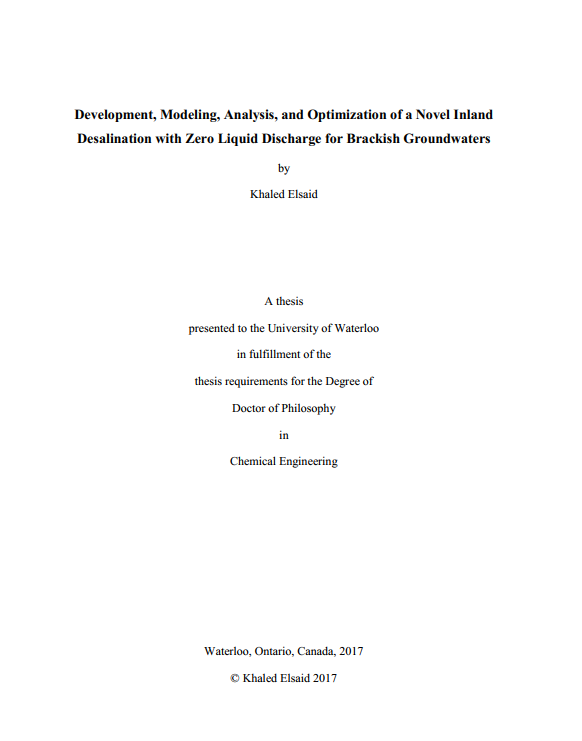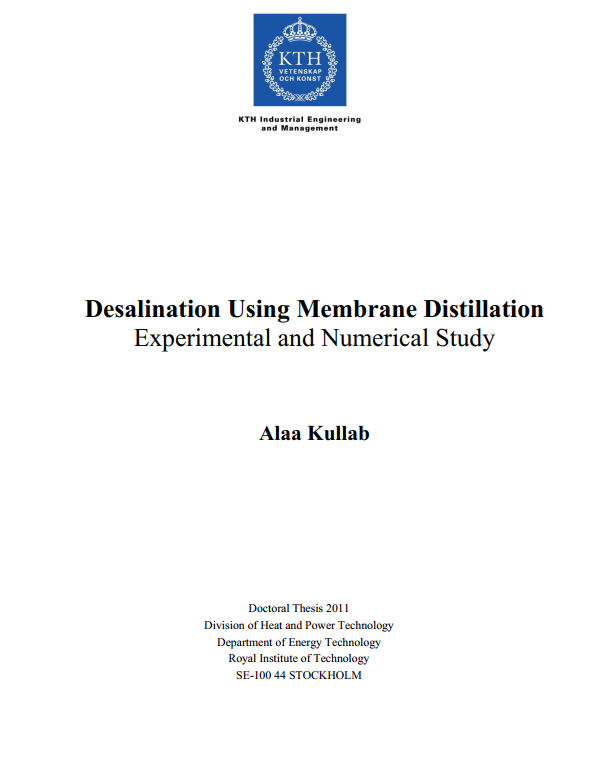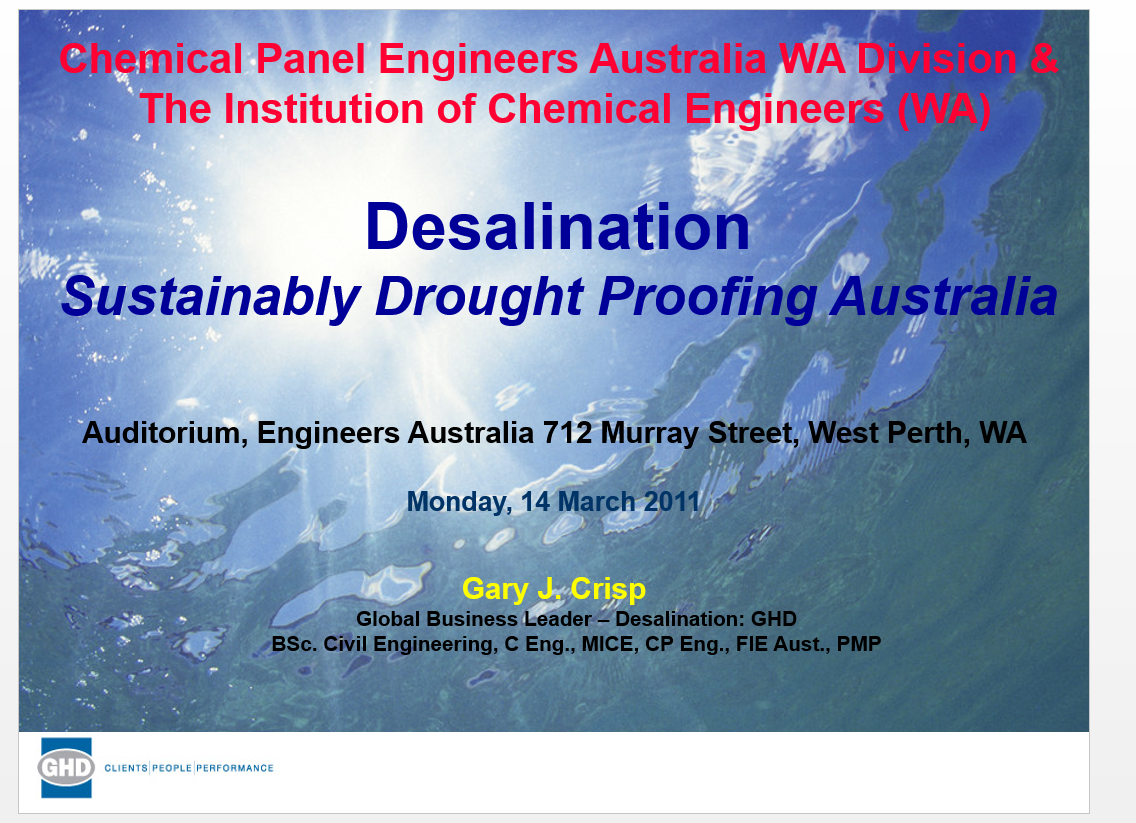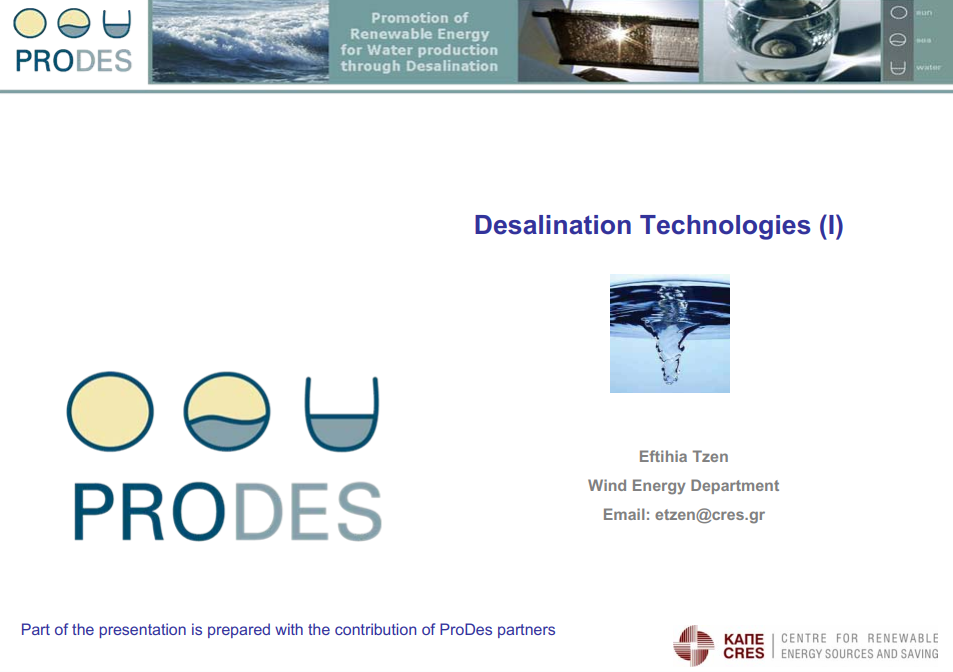Can emerging membrane-based desalination technologies replace reverse osmosis?
Abstract:
Growing uncertainty in the future availability of freshwater sources has led to an increase in installations for desalination of seawater. Reverse osmosis (RO), currently the most widely adopted desalination technique, has caused environmental concerns over the high associated greenhouse gas emissions and
generation of large amounts of chemicals-containing brine. Significant consumption of electricity for RO desalination is an additional challenge, particularly in remote locations. In this review, forward osmosis (FO), membrane distillation (MD) and capacitive deionization (CDI) are assessed as potential
substitute technologies and the major recent advancements in each field are discussed. These emerging technologies offer significant advantages over RO, such as higher salt rejection (CDI, MD), higher recovery of water (MD), fewer pre-treatment stages (MD, FO) and the ability to use low-grade energy
(MD, FO). In their current state, stand-alone technologies cannot compete with RO until certain challenges are addressed, including pore-wetting (MD) and high energy consumption (MD, CDI, FO). Hybrid systems that combine RO and emerging technologies may be useful for feed waters that cannot
be treated by RO alone and their benefits may be able to offset the increase in capital costs. These and other aspects, such as operational stability of hybrid systems, should be considered further in large-scale, long-term studies
Can emerging membrane-based desalination technologies replace reverse osmosis?
Abstract:
Growing uncertainty in the future availability of freshwater sources has led to an increase in installations for desalination of seawater. Reverse osmosis (RO), currently the most widely adopted desalination technique, has caused environmental concerns over the high associated greenhouse gas emissions and
generation of large amounts of chemicals-containing brine. Significant consumption of electricity for RO desalination is an additional challenge, particularly in remote locations. In this review, forward osmosis (FO), membrane distillation (MD) and capacitive deionization (CDI) are assessed as potential
substitute technologies and the major recent advancements in each field are discussed. These emerging technologies offer significant advantages over RO, such as higher salt rejection (CDI, MD), higher recovery of water (MD), fewer pre-treatment stages (MD, FO) and the ability to use low-grade energy
(MD, FO). In their current state, stand-alone technologies cannot compete with RO until certain challenges are addressed, including pore-wetting (MD) and high energy consumption (MD, CDI, FO). Hybrid systems that combine RO and emerging technologies may be useful for feed waters that cannot
be treated by RO alone and their benefits may be able to offset the increase in capital costs. These and other aspects, such as operational stability of hybrid systems, should be considered further in large-scale, long-term studies
Development of Photovoltaic Electrodialysis Desalination System
ABSTRACT:
The declining supply of drinking water for an increasing world population is a global concern with impacts on public health as well as micro and macro economies. A Photovoltaic Electrodialysis (PV-ED) unit is designed and constructed. The unit consists of a direct current power supply that charges batteries to provide a constant current to the unit. This includes an electrodialysis stack (desalinization unit), circulation pumps, a concentrate discharge unit, and a control unit to communicate between the photovoltaic and electrodialysis systems. The controller unit in conjunction with several sensors to monitor flow, conductivity, pressure, water elevation levels, and temperature creates a closed loop feedback system. The logic used in the control system was developed after physical construction of the unit. A closed loop feedback system allows battery charging, power regulation, and product water parameters to be precisely controlled while maintaining maximum efficiency. Based on the experience obtained during this research, the team at Cal Poly Pomona has estimated that this small PV-ED unit can be manufacture with a unit cost of $4,000. The Cal Poly Pomona team is looking into opportunities for implementation of this decentralized PV-ED unit in a disadvantaged community (DAC) in California.
Development of Photovoltaic Electrodialysis Desalination System
ABSTRACT:
The declining supply of drinking water for an increasing world population is a global concern with impacts on public health as well as micro and macro economies. A Photovoltaic Electrodialysis (PV-ED) unit is designed and constructed. The unit consists of a direct current power supply that charges batteries to provide a constant current to the unit. This includes an electrodialysis stack (desalinization unit), circulation pumps, a concentrate discharge unit, and a control unit to communicate between the photovoltaic and electrodialysis systems. The controller unit in conjunction with several sensors to monitor flow, conductivity, pressure, water elevation levels, and temperature creates a closed loop feedback system. The logic used in the control system was developed after physical construction of the unit. A closed loop feedback system allows battery charging, power regulation, and product water parameters to be precisely controlled while maintaining maximum efficiency. Based on the experience obtained during this research, the team at Cal Poly Pomona has estimated that this small PV-ED unit can be manufacture with a unit cost of $4,000. The Cal Poly Pomona team is looking into opportunities for implementation of this decentralized PV-ED unit in a disadvantaged community (DAC) in California.
Development, Modeling, Analysis, and Optimization of a Novel Inland Desalination with Zero Liquid Discharge for Brackish Groundwaters
ABSTRACT:
Groundwater is considered the major source of domestic water supply in many countries worldwide. In the absence of surface water supplies, the use of groundwater for domestic, agricultural, and even for industrial purposes becomes essential, especially in rural communities. Groundwater supplies typically are of good quality, and the quality is reasonably uniform throughout the year compared to that of surface water, thus making it suitable for direct use, or
simple to treat. A disadvantage of groundwater is the content of dissolved salt as many have a moderate-to-high salinity. The high salinity makes water brackish and thus it requires desalination before use. This has led to wide use of groundwater desalination to produce good-quality water in
many regions around the world. Nevertheless, a problem of desalination processes is the generation of a concentrate stream, sometimes called brine or reject, which must be properly managed. The management of brine from brackish groundwater desalination is a significant issue if located far from the coast (i.e. inland plants) or far from public channel to discharge such brine. Some options for brine disposal from inland desalination plants are evaporation ponds, deepwell injection, disposal to municipal sewers, and irrigation of plants tolerant to high salinities. Each of these disposal methods may result in many environmental problems such as groundwater contamination, the decline in crop yields from agricultural lands, the formation of eyesores, decreasing the efficiency of biological wastewater treatment, and making treated sewage effluent unsuitable for irrigation. As a result, the brine management from inland desalination of brackish groundwater is very critical, and the need for affordable and environmentally benign inland desalination has become crucial in many regions worldwide. This work aims to develop an efficient and environmentally benign process for inland desalination of brackish groundwater, which approaches zero liquid discharge (ZLD), maximizing the water produced and minimizing the volume of concentrate effluent. The technical approach
involves utilization of two-stage reverse osmosis (RO) units with the intermediate chemical treatment of brine stream that is designed to remove most of the scale-forming constituents, which foul membrane surface in RO and limits its water recovery and hence enable further recovery of water in the secondary RO unit.
Development, Modeling, Analysis, and Optimization of a Novel Inland Desalination with Zero Liquid Discharge for Brackish Groundwaters
ABSTRACT:
Groundwater is considered the major source of domestic water supply in many countries worldwide. In the absence of surface water supplies, the use of groundwater for domestic, agricultural, and even for industrial purposes becomes essential, especially in rural communities. Groundwater supplies typically are of good quality, and the quality is reasonably uniform throughout the year compared to that of surface water, thus making it suitable for direct use, or
simple to treat. A disadvantage of groundwater is the content of dissolved salt as many have a moderate-to-high salinity. The high salinity makes water brackish and thus it requires desalination before use. This has led to wide use of groundwater desalination to produce good-quality water in
many regions around the world. Nevertheless, a problem of desalination processes is the generation of a concentrate stream, sometimes called brine or reject, which must be properly managed. The management of brine from brackish groundwater desalination is a significant issue if located far from the coast (i.e. inland plants) or far from public channel to discharge such brine. Some options for brine disposal from inland desalination plants are evaporation ponds, deepwell injection, disposal to municipal sewers, and irrigation of plants tolerant to high salinities. Each of these disposal methods may result in many environmental problems such as groundwater contamination, the decline in crop yields from agricultural lands, the formation of eyesores, decreasing the efficiency of biological wastewater treatment, and making treated sewage effluent unsuitable for irrigation. As a result, the brine management from inland desalination of brackish groundwater is very critical, and the need for affordable and environmentally benign inland desalination has become crucial in many regions worldwide. This work aims to develop an efficient and environmentally benign process for inland desalination of brackish groundwater, which approaches zero liquid discharge (ZLD), maximizing the water produced and minimizing the volume of concentrate effluent. The technical approach
involves utilization of two-stage reverse osmosis (RO) units with the intermediate chemical treatment of brine stream that is designed to remove most of the scale-forming constituents, which foul membrane surface in RO and limits its water recovery and hence enable further recovery of water in the secondary RO unit.
Designing of Reverse Osmosis Desalination Plant in Jordan Valley Using Optimal Energy Options With Less Environmental Impacts
General introduction:
When population growing, water demand for domestic, agricultural and industrial needs is increasing. Fresh water resources are now widely exploited over the world due to increasing population and the amount of potable water will be decreased so, the other sources of water require some form of treatment before potable use without interruption and with reasonable cost to the consumer. Desalination technologies have appeared since 1950s at large scale plant with thermal processes like Multi Stage Flash Distillation (MSF) and Multi Effect Distillation (MED). Heating processes became established using the plenty
supply of available oil-driven energy for the required heating process[1]. The Reverse Osmosis (RO) process, developed since 1970s, is the main alternative to the previous technologies that require less amount of energy than thermal processes [1]. The desalination of ground water has more interest especially in Jordan Valley region due to high amount of salinity (Total Dissolve solids TDS). The design and operation of treatment plant depends on the feed water
quality in order to decide which pretreatment, feed pressure, recovery and waste disposable method is selected since the energy consumption is related directly to feed water TDS[2]
Designing of Reverse Osmosis Desalination Plant in Jordan Valley Using Optimal Energy Options With Less Environmental Impacts
General introduction:
When population growing, water demand for domestic, agricultural and industrial needs is increasing. Fresh water resources are now widely exploited over the world due to increasing population and the amount of potable water will be decreased so, the other sources of water require some form of treatment before potable use without interruption and with reasonable cost to the consumer. Desalination technologies have appeared since 1950s at large scale plant with thermal processes like Multi Stage Flash Distillation (MSF) and Multi Effect Distillation (MED). Heating processes became established using the plenty
supply of available oil-driven energy for the required heating process[1]. The Reverse Osmosis (RO) process, developed since 1970s, is the main alternative to the previous technologies that require less amount of energy than thermal processes [1]. The desalination of ground water has more interest especially in Jordan Valley region due to high amount of salinity (Total Dissolve solids TDS). The design and operation of treatment plant depends on the feed water
quality in order to decide which pretreatment, feed pressure, recovery and waste disposable method is selected since the energy consumption is related directly to feed water TDS[2]
Designing And Optimizing 10,000 m 3 /day Conventional SWRO Desalination plant
ABSTRACT:
Desalination of seawater has been considered as one of the most promising techniques for supplying a fresh water in Libya. Reverse osmosis (RO) is one of the main technologies for big size desalination plants for the reason that it offers an ability of producing a high quality and quantity of fresh water
from seawater with a minor specific energy consumption compared to the other thermal evaporation processes. This paper aims to collect and apply the most useful mathematical equations and software of designing a seawater RO desalination plant with a capacity of 10,000 m3/day. Moreover, its
pretreatment equipment such as sedimentation tank, high-pressure pump, multimedia and cartridge filters. IMSdesign software developed by Nitto Hydranuatics Company used for designing and optimizing the membrane assembly of the suggested plant. Additionally, the energy recovery device (ERD)
specification accomplished by the same earlier software. In addition, the recommended antiscalant dose predicted by PWT ProDose software. The recovery of the plant increased to more than 40% with less number of membrane elements due to installing new advanced membranes (SWC6 MAX) developed by Nitto Hydranuatics Company. Moreover, pressure exchanger device recommended for the designed plant to decrease the specific pumping energy from 4.81 kWh/m3 to 2.09 kWh/m3, which saves more energy, thus, decreases the unit product cost of the plant.
Designing And Optimizing 10,000 m 3 /day Conventional SWRO Desalination plant
ABSTRACT:
Desalination of seawater has been considered as one of the most promising techniques for supplying a fresh water in Libya. Reverse osmosis (RO) is one of the main technologies for big size desalination plants for the reason that it offers an ability of producing a high quality and quantity of fresh water
from seawater with a minor specific energy consumption compared to the other thermal evaporation processes. This paper aims to collect and apply the most useful mathematical equations and software of designing a seawater RO desalination plant with a capacity of 10,000 m3/day. Moreover, its
pretreatment equipment such as sedimentation tank, high-pressure pump, multimedia and cartridge filters. IMSdesign software developed by Nitto Hydranuatics Company used for designing and optimizing the membrane assembly of the suggested plant. Additionally, the energy recovery device (ERD)
specification accomplished by the same earlier software. In addition, the recommended antiscalant dose predicted by PWT ProDose software. The recovery of the plant increased to more than 40% with less number of membrane elements due to installing new advanced membranes (SWC6 MAX) developed by Nitto Hydranuatics Company. Moreover, pressure exchanger device recommended for the designed plant to decrease the specific pumping energy from 4.81 kWh/m3 to 2.09 kWh/m3, which saves more energy, thus, decreases the unit product cost of the plant.
Design Of A Desalination Plant Aspects To Consider
Abstract: One of the main problems our actual society faces is the shortage of water. Despite the great effort made by authorities and researchers, multiple countries with poor economic resources are experiencing serious difficulties derivative of water scarcity. Desalination provides a feasible solution for inland and coastal areas. Through literature and reviewed articles analysis the reader will meet the actual issues regarding designing a desalination plant, and more over with reverse osmosis (RO) processes, which are the main arguments of this work. One of the big deals is the environmental concern when handling the concentrate disposal. Another important point about desalination processes is the increasingly interest in coupling the units with renewable energy sources (RES). The results point out that regardless of the efforts made until today, additional achievement is required in fields such as membrane’s structure materials for RO method, concentrate disposal systems, governmental water policies review and update, and greater distinction researches between brackish water and seawater RO desalination processes. Taking into consideration the previous outcomes it is finally concluded that some particular steps must be accomplished when beginning a desalination plant design
Design Of A Desalination Plant Aspects To Consider
Abstract: One of the main problems our actual society faces is the shortage of water. Despite the great effort made by authorities and researchers, multiple countries with poor economic resources are experiencing serious difficulties derivative of water scarcity. Desalination provides a feasible solution for inland and coastal areas. Through literature and reviewed articles analysis the reader will meet the actual issues regarding designing a desalination plant, and more over with reverse osmosis (RO) processes, which are the main arguments of this work. One of the big deals is the environmental concern when handling the concentrate disposal. Another important point about desalination processes is the increasingly interest in coupling the units with renewable energy sources (RES). The results point out that regardless of the efforts made until today, additional achievement is required in fields such as membrane’s structure materials for RO method, concentrate disposal systems, governmental water policies review and update, and greater distinction researches between brackish water and seawater RO desalination processes. Taking into consideration the previous outcomes it is finally concluded that some particular steps must be accomplished when beginning a desalination plant design
Desalination with Zero Liquid Discharge for Brackish Groundwaters
ABSTRACT:
Groundwater is considered the major source of domestic water supply in many countries worldwide. In the absence of surface water supplies, the use of groundwater for domestic, agricultural, and even for industrial purposes becomes essential, especially in rural communities. Groundwater supplies typically are of good quality, and the quality is reasonably uniform throughout the year compared to that of surface water, thus making it suitable for direct use, or
simple to treat. A disadvantage of groundwater is the content of dissolved salt as many have a moderate-to-high salinity. The high salinity makes water brackish and thus it requires desalination before use. This has led to wide use of groundwater desalination to produce good-quality water in many regions around the world. Nevertheless, a problem of desalination processes is the generation of a concentrate stream, sometimes called brine or reject, which must be properly managed. The management of brine from brackish groundwater desalination is a significant issue if located far from the coast (i.e. inland plants) or far from public channel to discharge such brine.
Desalination with Zero Liquid Discharge for Brackish Groundwaters
ABSTRACT:
Groundwater is considered the major source of domestic water supply in many countries worldwide. In the absence of surface water supplies, the use of groundwater for domestic, agricultural, and even for industrial purposes becomes essential, especially in rural communities. Groundwater supplies typically are of good quality, and the quality is reasonably uniform throughout the year compared to that of surface water, thus making it suitable for direct use, or
simple to treat. A disadvantage of groundwater is the content of dissolved salt as many have a moderate-to-high salinity. The high salinity makes water brackish and thus it requires desalination before use. This has led to wide use of groundwater desalination to produce good-quality water in many regions around the world. Nevertheless, a problem of desalination processes is the generation of a concentrate stream, sometimes called brine or reject, which must be properly managed. The management of brine from brackish groundwater desalination is a significant issue if located far from the coast (i.e. inland plants) or far from public channel to discharge such brine.
Desalination, With A Grain Of Salt
Introduction:
THE OCEANS CONTAIN 97% of the Earth’s water. This water is too salty for humans to use for irrigation, drinking, and most commercial and industrial purposes. Because of growing concerns about water scarcity and quality, and disputes over allocations of scarce water resources, a tremendous amount of effort has been devoted to developing technologies to desalinate the vast quantities of seawater available. While substantial progress has been made in recent years, desalination remains a minor source of water in all but the wealthiest, most water-scarce regions. In particular, desalination remains too expensive to be a primary source of fresh water and presents significant social, environmental, and technological obstacles that must be overcome. Nevertheless, in some regions, water planners are looking to desalination as a way to overcome natural limitations on freshwater availability, quality, and reliability. This report provides a comprehensive overview of the benefits and risks of desalination and the barriers that hinder more widespread use of this
technology. It does not address whether desalination is needed in California, nor does it comprehensively compare this supply option with other options, such as conservation, conjunctive use, or water recycling. Previous work at the Pacific Institute suggests that water continues to be used wastefully in California and that substantial amounts of water can be conserved cost-effectively compared to almost all proposed supply expansions, including desalination
Desalination, With A Grain Of Salt
Introduction:
THE OCEANS CONTAIN 97% of the Earth’s water. This water is too salty for humans to use for irrigation, drinking, and most commercial and industrial purposes. Because of growing concerns about water scarcity and quality, and disputes over allocations of scarce water resources, a tremendous amount of effort has been devoted to developing technologies to desalinate the vast quantities of seawater available. While substantial progress has been made in recent years, desalination remains a minor source of water in all but the wealthiest, most water-scarce regions. In particular, desalination remains too expensive to be a primary source of fresh water and presents significant social, environmental, and technological obstacles that must be overcome. Nevertheless, in some regions, water planners are looking to desalination as a way to overcome natural limitations on freshwater availability, quality, and reliability. This report provides a comprehensive overview of the benefits and risks of desalination and the barriers that hinder more widespread use of this
technology. It does not address whether desalination is needed in California, nor does it comprehensively compare this supply option with other options, such as conservation, conjunctive use, or water recycling. Previous work at the Pacific Institute suggests that water continues to be used wastefully in California and that substantial amounts of water can be conserved cost-effectively compared to almost all proposed supply expansions, including desalination
Desalination Using Membrane Distillation Experimental and Numerical Study
ABSTRACT:
Desalination has been increasingly adopted over the last decades as an option, and sometimes as a necessity to overcome water shortages in many areas around the world. Today, several thermal and physical separation technologies are well established in large scale production for domestic and industrial purposes. Membrane distillation is a novel thermally-driven process that can be adapted effectively for water desalination or water treatment in industrial
applications, due to its potential lower energy consumption and simplicity. The general objective of this thesis is to contribute to the technical understanding of membrane distillation as a new technology in water treatment for both industrial and drinking water purposes, as a starting point for further improvement. The thesis includes experimental and numerical investigations that highlight some aspects of the technology application and fundamental aspects. In the field of industrial application, an experimental and numerical assessment has been carried out on an Air Gap Membrane Distillation (AGMD) prototype to assess the utilization of the technology in thermal cogeneration plants; in particular, demineralization of water boiler feed water and treating flue gas condensate. The main assessment parameters were water quality and energy consumption. The results from full-scale simulations of a system of 10 m3/hr production capacity, connected to the district heating network were as follows: 5 to 12 kWh/m3 specific thermal energy consumption, and 0,6 to 1,5 kWh/m3 specific electricity consumption, depending upon the heat source (district heat supply line or low-grade steam). For desalination applications, experimental and simulation work was conducted on an AGMD semi-commercial system as part of the EU MEDESOL project. The aim was to evaluate AGMD performance with saline water of 35 g/l NaCl in order to establish an operation data base for simulation of a three-stage AGMD desalination system. Specific thermal energy consumption was calculated as 950 kWht/m3 for a layout without heat recovery, and 850 kWht/m3 for a layout with one stage heat recovery. The lack of internal heat recovery in the current MD module means that most of the heat supplied to MD system was not utilized efficiently, so the thermal energy consumption is high. This would mean that a large solar field is needed.
Desalination Using Membrane Distillation Experimental and Numerical Study
ABSTRACT:
Desalination has been increasingly adopted over the last decades as an option, and sometimes as a necessity to overcome water shortages in many areas around the world. Today, several thermal and physical separation technologies are well established in large scale production for domestic and industrial purposes. Membrane distillation is a novel thermally-driven process that can be adapted effectively for water desalination or water treatment in industrial
applications, due to its potential lower energy consumption and simplicity. The general objective of this thesis is to contribute to the technical understanding of membrane distillation as a new technology in water treatment for both industrial and drinking water purposes, as a starting point for further improvement. The thesis includes experimental and numerical investigations that highlight some aspects of the technology application and fundamental aspects. In the field of industrial application, an experimental and numerical assessment has been carried out on an Air Gap Membrane Distillation (AGMD) prototype to assess the utilization of the technology in thermal cogeneration plants; in particular, demineralization of water boiler feed water and treating flue gas condensate. The main assessment parameters were water quality and energy consumption. The results from full-scale simulations of a system of 10 m3/hr production capacity, connected to the district heating network were as follows: 5 to 12 kWh/m3 specific thermal energy consumption, and 0,6 to 1,5 kWh/m3 specific electricity consumption, depending upon the heat source (district heat supply line or low-grade steam). For desalination applications, experimental and simulation work was conducted on an AGMD semi-commercial system as part of the EU MEDESOL project. The aim was to evaluate AGMD performance with saline water of 35 g/l NaCl in order to establish an operation data base for simulation of a three-stage AGMD desalination system. Specific thermal energy consumption was calculated as 950 kWht/m3 for a layout without heat recovery, and 850 kWht/m3 for a layout with one stage heat recovery. The lack of internal heat recovery in the current MD module means that most of the heat supplied to MD system was not utilized efficiently, so the thermal energy consumption is high. This would mean that a large solar field is needed.
Desalination Technology Trends
Abstract:
Texas’ increased interest in desalination reflects a worldwide trend to include it as a viable alternative water supply option in any long-term water strategy. Recent technological developments and new methods of project delivery are driving this heightened level of interest to the point that desalination is now being seriously evaluated on projects where it would not have been considered ten years ago. The most significant trend in desalination is the increased growth of the reverse osmosis(RO) market. Technological improvements have both dramatically increased the performance of RO membranes. Today’s membranes are more efficient, more durable, and much less expensive. Improvements in membrane technology are complimented by improvements in pretreatment technology, which allow RO membranes to be considered on a much wider range of applications. Energy costs are directly related to the salt content of the water source, and may represent up to 50% of a system’s operational costs. There has been a growing trend to reduce energy costs through improvements in membrane performance and by employing modern, mechanical energy recovery devices that reduce energy requirements by 10-50%. The growing trend to build larger desalination plants recognizes the inherent modularity of RO systems and the fact that the development, design, and permitting costs are somewhat independent of plant size. The result is that larger plants are being constructed to take advantage of economies-of-scale, which reduce the unit cost of desalinated water. Other trends that will be reviewed in more detail include the co-siting of desalination plants with electric power generating plants and other industrial facilities, and the hybridization of distillation and membrane processes.
Desalination Technology Trends
Abstract:
Texas’ increased interest in desalination reflects a worldwide trend to include it as a viable alternative water supply option in any long-term water strategy. Recent technological developments and new methods of project delivery are driving this heightened level of interest to the point that desalination is now being seriously evaluated on projects where it would not have been considered ten years ago. The most significant trend in desalination is the increased growth of the reverse osmosis(RO) market. Technological improvements have both dramatically increased the performance of RO membranes. Today’s membranes are more efficient, more durable, and much less expensive. Improvements in membrane technology are complimented by improvements in pretreatment technology, which allow RO membranes to be considered on a much wider range of applications. Energy costs are directly related to the salt content of the water source, and may represent up to 50% of a system’s operational costs. There has been a growing trend to reduce energy costs through improvements in membrane performance and by employing modern, mechanical energy recovery devices that reduce energy requirements by 10-50%. The growing trend to build larger desalination plants recognizes the inherent modularity of RO systems and the fact that the development, design, and permitting costs are somewhat independent of plant size. The result is that larger plants are being constructed to take advantage of economies-of-scale, which reduce the unit cost of desalinated water. Other trends that will be reviewed in more detail include the co-siting of desalination plants with electric power generating plants and other industrial facilities, and the hybridization of distillation and membrane processes.
Desalination Technology Trends And CH2M HILL
Presentation Outline:
- The Growing Desalination Market
- Trends in the Technology/Virtual expo
- Thermal Desalination
Desalination Technology Trends And CH2M HILL
Presentation Outline:
- The Growing Desalination Market
- Trends in the Technology/Virtual expo
- Thermal Desalination
Desalination Plant Basis Of Design
Overview:
The project potable water requirements will be provided using single desalination plant with the Grand Bahama Port Authority water supply serving as the backup source. The overall desalination treatment process will consist of feedwater pumping, bag filtration, optional media filtration, the addition of a scale
inhibitor, cartridge filtration, membrane separation, forced air degasification, re-pumping, and post treatment. Provisions have been included to bypass the post treatment systems for the production of irrigation water. The post aeration re-pump station will be designed to transfer either type of water to the
appropriate storage tanks located within the project. Membrane concentrate will be disposed via an injection well to be constructed as part of this project.
The desalination process will consist of a dual treatment units or “trains” each equipped with a positive displacement axial piston first pass membrane feed pump, first pass membrane array, energy recovery system, second pass membrane feed pump, second pass membrane array, high- and low-pressure
piping and instrumentation. The second pass system is designed to treat up to 60 percent of the first pass permeate. A membrane cleaning/flush system will be provided. The membrane post treatment will be designed to receive the flow from both units and consists of a forced air degasified, repumping, recarbonation, calcium carbonate up flow contactors to boost finished water hardness and alkalinity concentrations; and three chemical feed systems for the metering of a corrosion inhibitor, dilute hydrochloric acid for pH adjustment and sodium hypochlorite for residual disinfection. The final pH and chlorine residual will be controlled and recorded by a separate system. The following sections describe the various aspects of the facility in greater detail. Process flow
schematics are presented in Appendix A.
Desalination Plant Basis Of Design
Overview:
The project potable water requirements will be provided using single desalination plant with the Grand Bahama Port Authority water supply serving as the backup source. The overall desalination treatment process will consist of feedwater pumping, bag filtration, optional media filtration, the addition of a scale
inhibitor, cartridge filtration, membrane separation, forced air degasification, re-pumping, and post treatment. Provisions have been included to bypass the post treatment systems for the production of irrigation water. The post aeration re-pump station will be designed to transfer either type of water to the
appropriate storage tanks located within the project. Membrane concentrate will be disposed via an injection well to be constructed as part of this project.
The desalination process will consist of a dual treatment units or “trains” each equipped with a positive displacement axial piston first pass membrane feed pump, first pass membrane array, energy recovery system, second pass membrane feed pump, second pass membrane array, high- and low-pressure
piping and instrumentation. The second pass system is designed to treat up to 60 percent of the first pass permeate. A membrane cleaning/flush system will be provided. The membrane post treatment will be designed to receive the flow from both units and consists of a forced air degasified, repumping, recarbonation, calcium carbonate up flow contactors to boost finished water hardness and alkalinity concentrations; and three chemical feed systems for the metering of a corrosion inhibitor, dilute hydrochloric acid for pH adjustment and sodium hypochlorite for residual disinfection. The final pH and chlorine residual will be controlled and recorded by a separate system. The following sections describe the various aspects of the facility in greater detail. Process flow
schematics are presented in Appendix A.



















